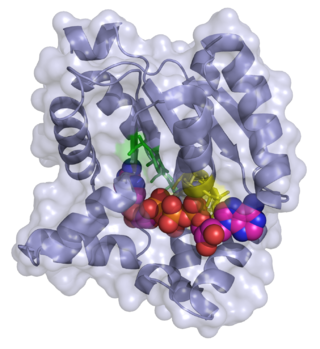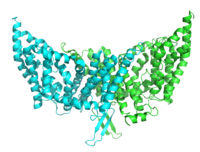
In biochemistry, a kinase is an enzyme that catalyzes the transfer of phosphate groups from high-energy, phosphate-donating molecules to specific substrates. This process is known as phosphorylation, where the high-energy ATP molecule donates a phosphate group to the substrate molecule. This transesterification produces a phosphorylated substrate and ADP. Conversely, it is referred to as dephosphorylation when the phosphorylated substrate donates a phosphate group and ADP gains a phosphate group. These two processes, phosphorylation and dephosphorylation, occur four times during glycolysis.

Mannose is a sugar monomer of the aldohexose series of carbohydrates. It is a C-2 epimer of glucose. Mannose is important in human metabolism, especially in the glycosylation of certain proteins. Several congenital disorders of glycosylation are associated with mutations in enzymes involved in mannose metabolism.

Adenylate kinase is a phosphotransferase enzyme that catalyzes the interconversion of the various adenosine phosphates. By constantly monitoring phosphate nucleotide levels inside the cell, ADK plays an important role in cellular energy homeostasis.
PEP group translocation, also known as the phosphotransferase system or PTS, is a distinct method used by bacteria for sugar uptake where the source of energy is from phosphoenolpyruvate (PEP). It is known to be a multicomponent system that always involves enzymes of the plasma membrane and those in the cytoplasm.

Phosphofructokinase (PFK) is a kinase enzyme that phosphorylates fructose 6-phosphate in glycolysis.

In enzymology, a phosphoenolpyruvate mutase is an enzyme that catalyzes the chemical reaction

In the field of molecular biology, a two-component regulatory system serves as a basic stimulus-response coupling mechanism to allow organisms to sense and respond to changes in many different environmental conditions. Two-component systems typically consist of a membrane-bound histidine kinase that senses a specific environmental stimulus and a corresponding response regulator that mediates the cellular response, mostly through differential expression of target genes. Although two-component signaling systems are found in all domains of life, they are most common by far in bacteria, particularly in Gram-negative and cyanobacteria; both histidine kinases and response regulators are among the largest gene families in bacteria. They are much less common in archaea and eukaryotes; although they do appear in yeasts, filamentous fungi, and slime molds, and are common in plants, two-component systems have been described as "conspicuously absent" from animals.
In enzymology, a [3-methyl-2-oxobutanoate dehydrogenase (acetyl-transferring)] is an enzyme that catalyzes the chemical reaction
In enzymology, arginine kinase is an enzyme that catalyzes the chemical reaction
In enzymology, a phosphoenolpyruvate-protein phosphotransferase is an enzyme that catalyzes the chemical reaction
In enzymology, a protein-Npi-phosphohistidine-sugar phosphotransferase is an enzyme that catalyzes the chemical reaction

Pyruvate, phosphate dikinase, or PPDK is an enzyme in the family of transferases that catalyzes the chemical reaction

Shikimate kinase (EC 2.7.1.71) is an enzyme that catalyzes the ATP-dependent phosphorylation of shikimate to form shikimate 3-phosphate. This reaction is the fifth step of the shikimate pathway, which is used by plants and bacteria to synthesize the common precursor of aromatic amino acids and secondary metabolites. The systematic name of this enzyme class is ATP:shikimate 3-phosphotransferase. Other names in common use include shikimate kinase (phosphorylating), and shikimate kinase II.

Histidine-containing phosphocarrier protein (HPr) is a small cytoplasmic protein that is a component of the phosphoenolpyruvate-dependent sugar phosphotransferase system (PTS).
The phosphotransferases system (PTS-GFL) superfamily is a superfamily of phosphotransferase enzymes that facilitate the transport of glucose, glucitol (G), fructose (F) and lactose (L). Classification has been established through phylogenic analysis and bioinformatics.
The PTSGlucose-Glucoside (Glc) family includes porters specific for glucose, glucosamine, N-acetylglucosamine and a large variety of α- and β-glucosides, and is part of the PTS-GFL superfamily.
The PTS Fructose-Mannitol (Fru) Family is a large and complex family that is part of the PTS-GFL superfamily. It includes several sequenced fructose, mannose and mannitol-specific porters, as well as several putative PTS porters of unknown specificities. The fructose porters of this family phosphorylate fructose on the 1-position. Those of TC family 4.A.6 phosphorylate fructose on the 6-position.
The PTS Lactose-N,N’-Diacetylchitobiose (Lac) Family includes several sequenced lactose porters of Gram-positive bacteria, as well as the Escherichia coli and Borrelia burgdorferi N,N'-diacetylchitobiose (Chb) porters. It is part of the PTS-GFL superfamily. The former can transport aromatic β-glucosides and cellobiose, as well as Chb. However, only Chb induces expression of the chb operon.
Permease of phosphotransferase system is a superfamily of phosphotransferase enzymes that facilitate the transport of L-ascorbate (A) and galactitol (G). Classification has been established through phylogenic analysis and bioinformatics.
The PTS Mannose-Fructose-Sorbose (Man) Family is a group of multicomponent PTS systems that are involved in sugar uptake in bacteria. This transport process is dependent on several cytoplasmic phosphoryl transfer proteins - Enzyme I (I), HPr, Enzyme IIA (IIA), and Enzyme IIB (IIB) as well as the integral membrane sugar permease complex (IICD). It is not part of the PTS-AG or PTS-GFL superfamilies.









